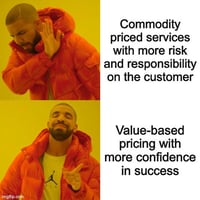Image courtesy Drake's "Hotline Bling" music video and imgflip.com for help in generation We've...
Value-Based Pricing For Your Tech Services 2: Pricing Models

In our previous article, we gained an understanding of value and how it relates to price. This article describes the most common pricing models you will use in your tech services.
Hourly Pricing
Hourly pricing is as straightforward as it gets. But underpinning the hourly pricing is a cost-plus model. Hourly pricing focuses on the cost to the provider or person-hours rather than the value delivered or outcomes. But it is a good starting point.
|
|
Vendor |
Customer |
|
Pros |
Easy to implement |
Easy to understand |
|
|
Scoping is lower stakes |
Flexibility to address changes |
|
Cons |
Higher hurdle for proof of competence |
Fewer assurances on time and cost |
|
|
Cost-based pricing and lower margins |
Usually lower pricing |
|
|
Maintaining the relationship may still require the vendor to assume responsibility for scoping mistakes despite the contractual standing |
|
Project-Based Pricing
Project-based pricing revolves around a fixed cost for a fixed scope for a project. This model offers predictability and a clear focus on outcomes for the customer. It gives customers clarity and confidence in the costs, but the company assumes more risk. But the most significant risk is expressed in the Agile Manifesto as "Customer collaboration over contract negotiation."
|
Vendor |
Customer |
|
|
Pros |
Scope and fixed-price acts as proof of competence |
Clear understanding of costs |
|
|
Presumption of risk allows you to increase price to command a higher margin |
|
|
|
Increased efficiencies are extremely lucrative |
|
|
Cons |
Scoping processes need to be strengthened |
The vendor is incentivized marking completion, not project success |
|
|
A scoping mistake can destroy margins |
Can create a false sense of security |
|
|
Change requests need to be aggressively managed |
|
|
|
Cashflow is worse because it is dependent on completion |
|
Milestone-Based Pricing
Milestone-based pricing applies the lean principle of smaller batch sizes to the project-based pricing model. This approach offers a balance between flexibility and structure, allowing for payments to be made upon the completion of specific agreed-upon phases and for making adjustments as we move forward. Agile contracts are an example of a milestone-based model.
|
Vendor |
Customer |
|
|
Pros |
Consistent cashflow |
Flexibility to readjust strategy |
|
Scope change translates to an increased revenue opportunity |
Address the underlying problems in both fixed and hourly pricing head-on |
|
|
The risk from scoping mistakes is greatly reduced |
|
|
|
Cons |
Need strong product leadership for the duration of the project |
Fewer guarantees on costs |
|
|
|
Harder to understand |
Subscription
Subscription pricing is an ongoing, periodic charge that provides customers with services and support. This model encourages long-term relationships and can lead to a stable, predictable revenue stream. It's ideal for services that require continuous upkeep, updates, or regular input. For the client, it ensures both ongoing and emergency support.
|
|
Vendors |
Customers |
|
Pros |
Very high-quality revenue: consistent, sticky, and high-margin |
The customer has support for emergencies |
|
|
Can develop automations for improved margins |
Benefit from lower costs from scale of vendor |
|
|
Creates opportunities cross-selling |
|
|
|
Increases company valuation more than other forms of revenue |
|
|
Cons |
Need a minimum scale to be cost-efficient |
Cost is usually more than the equivalent hours worked |
|
|
Estimating costs can be difficult without real-world data, especially for your first few deals |
|
Retainer
Retainer pricing is an agreement where clients pay a recurring fee, typically monthly, for a minimum number of hours. This model guarantees availability and priority service over non-retainer clients. It's best suited for clients who need consistent work but not enough to justify a full-time position. For service providers, retainers mean predictable income and deeper client relationships.
|
|
Vendors |
Customers |
|
Pros |
Consistent revenue that increases customer consistency |
The customer has access for emergencies |
|
|
Create opportunities for cross-selling |
|
|
|
Easier to implement than a subscription |
|
|
Cons |
Can be disruptive to the team until a minimum scale is reached |
Use it or lose it setup continuously makes the customer question value |
Performance-Based Pricing
Performance-based pricing ties the provider's compensation to the value delivered, such as cost savings or revenue growth. It's a high-stakes model that rewards successful outcomes and is more common in sales than tech services. Venture studios use performance-based pricing for tech services. In addition, some tech services companies offer it for savings cost savings. This model is rare for tech services, but the key to implementing this model is to provide proof of value delivered or good data practices. This is a great practice to maintain.
|
|
Vendors |
Customers |
|
Pros |
Highest margin with likely >10% value capture |
Minimum risk to customer |
|
|
The implementation itself is the proof of competence |
The highest chance of success because of complete alignment of goals |
|
Get data infrastructure to conduct better experiments |
||
|
Cons |
Compensation includes factors outside the control of vendor |
Higher overall cost than if you can develop the expertise in-house |
|
|
Need to develop data practices to showcase outcomes |
|
Pricing Model and Tech Services Strategy
Choosing the right pricing model is critical to the health of your tech services business. By considering the pros and cons for both your company and your customers. Two things to keep in mind:
-
You can mix and match models.
-
You can capture some of the goodness of other models by following their best practices despite what the contract says.
Your pricing model critically impacts both the sales and delivery of your services. Subscribe to our blog or follow us on LinkedIn to ensure you don't miss out as we explore this connection further.




